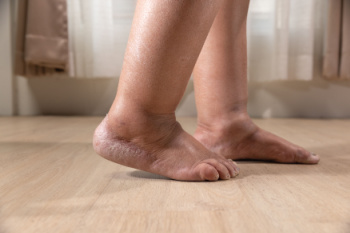Items filtered by date: July 2024
Get Professional Care for a Broken Foot or Ankle
Essential Diabetic Foot Care

Diabetes is a chronic condition that affects the body's ability to regulate blood sugar levels, often leading to complications in the feet. High blood sugar can damage blood vessels and nerves, reducing circulation and sensation in the feet. This makes individuals with diabetes more susceptible to foot injuries and infections, as they may not feel wounds or pressure sores developing. If not properly treated, even minor foot injuries can lead to serious complications, such as ulcers, infections, or in severe cases, amputation. Proper diabetic foot care includes regular inspection of the feet for cuts, blisters, or sores, keeping the feet clean and dry, and wearing properly fitted shoes to avoid friction. Preventive measures like controlling blood sugar levels, regular foot check-ups with a podiatrist, and proper foot hygiene are imperative to avoiding serious complications and maintaining overall foot health. If you have diabetes and notice a foot wound, it is essential to see a podiatrist promptly to prevent an infection.
Diabetic foot care is important in preventing foot ailments such as ulcers. If you are suffering from diabetes or have any other concerns about your feet, contact Thomas Vail, DPM from Step Alive Foot & Ankle Center. Our doctor can provide the care you need to keep you pain-free and on your feet.
Diabetic Foot Care
Diabetes affects millions of people every year. The condition can damage blood vessels in many parts of the body, especially the feet. Because of this, taking care of your feet is essential if you have diabetes, and having a podiatrist help monitor your foot health is highly recommended.
The Importance of Caring for Your Feet
- Routinely inspect your feet for bruises or sores.
- Wear socks that fit your feet comfortably.
- Wear comfortable shoes that provide adequate support.
Patients with diabetes should have their doctor monitor their blood levels, as blood sugar levels play such a huge role in diabetic care. Monitoring these levels on a regular basis is highly advised.
It is always best to inform your healthcare professional of any concerns you may have regarding your feet, especially for diabetic patients. Early treatment and routine foot examinations are keys to maintaining proper health, especially because severe complications can arise if proper treatment is not applied.
If you have any questions please feel free to contact our office located in Findlay, OH . We offer the newest diagnostic and treatment technologies for all your foot and ankle needs.
Causes of Swollen Feet From Daily Activities

Swollen feet, or edema, can result from various factors. Spending long hours on your feet, such as during extended work shifts or prolonged standing, can cause fluid to accumulate in the lower extremities. Excessive salt intake contributes to fluid retention, exacerbating swelling. Injuries, such as sprains or fractures, often lead to localized swelling as part of the body's inflammatory response. Pregnancy also commonly causes swollen feet due to increased blood volume and pressure on the veins. Each of these causes affects fluid balance and circulation, leading to discomfort and visible swelling. If you notice your ankles and feet have become swollen, it is suggested that you contact a podiatrist who can accurately determine the cause, and offer you effective relief methods.
Swollen feet can be a sign of an underlying condition. If you have any concerns, contact Thomas Vail, DPM of Step Alive Foot & Ankle Center. Our doctor can provide the care you need to keep you pain-free and on your feet.
Swollen feet are a common ailment among pregnant women and people who stand or sit for extended periods. Aging may increase the possibility of swollen feet and patients who are obese often notice when their feet are swelling too. There may be medical reasons why swollen feet occur:
- Phlebitis - A condition that causes the veins to become inflamed and can also cause leg pain.
- Liver disease - This may lead to low blood levels of albumin which is a protein. This can cause fluid in the blood to pass into the tissues and several areas of the body can become swollen.
- Heart failure - When the heart doesn’t pump properly the blood that is normally pumped back to the heart can pool in the veins of the legs causing swollen feet.
- Kidney disease - One of the main functions of the kidneys is releasing excess fluid in the body. This type of condition can make it difficult for the kidneys to function properly, and as a result the feet may become swollen.
- Deep-vein thrombosis (DVT)- This is a serious condition where blood clots form in the veins of the legs. They can block the return of blood from the legs to the heart which may cause the feet to swell. It is important to be treated by a podiatrist if this condition is present.
Swollen feet can also be caused by bone and tendon conditions, including fractures, arthritis, and tendinitis. Additionally, there may be skin and toenail conditions and an infection may cause the feet to swell. Patients who take medicine to treat high blood pressure may be prone to getting swollen feet.
Many patients elevate their feet to help relieve the swelling and this is generally a temporary remedy. When a podiatrist is consulted the reason behind the swelling can be uncovered and subsequently treated.
If you have any questions please feel free to contact our office located in Findlay, OH . We offer the newest diagnostic tools and technology to treat your foot and ankle needs.
Biomechanical Foot Assessment
 A biomechanical assessment of the foot and ankle is a detailed evaluation conducted to understand the movement patterns and structural alignment of these areas. This assessment involves examining how the foot and ankle move during various activities, such as walking or running and identifying any abnormalities or dysfunctions. The primary purpose of a biomechanical assessment is to diagnose issues that may cause pain, discomfort, or impaired function. Common conditions identified through this process can include flat feet, overpronation, supination, and alignment issues affecting the knees, hips, and lower back. The assessment typically includes visual and physical examinations, gait analysis, and sometimes advanced imaging techniques. Conducting a biomechanical assessment is important for developing personalized treatment plans. It helps in prescribing appropriate orthotics, footwear, and exercises to correct identified problems. This evaluation is essential for athletes, individuals with chronic pain, and those recovering from injuries. If you have chronic foot or ankle pain, it is suggested that you visit a podiatrist for a biomechanical assessment and treatment based on results.
A biomechanical assessment of the foot and ankle is a detailed evaluation conducted to understand the movement patterns and structural alignment of these areas. This assessment involves examining how the foot and ankle move during various activities, such as walking or running and identifying any abnormalities or dysfunctions. The primary purpose of a biomechanical assessment is to diagnose issues that may cause pain, discomfort, or impaired function. Common conditions identified through this process can include flat feet, overpronation, supination, and alignment issues affecting the knees, hips, and lower back. The assessment typically includes visual and physical examinations, gait analysis, and sometimes advanced imaging techniques. Conducting a biomechanical assessment is important for developing personalized treatment plans. It helps in prescribing appropriate orthotics, footwear, and exercises to correct identified problems. This evaluation is essential for athletes, individuals with chronic pain, and those recovering from injuries. If you have chronic foot or ankle pain, it is suggested that you visit a podiatrist for a biomechanical assessment and treatment based on results.
If you have any concerns about your feet, contact Thomas Vail, DPM from Step Alive Foot & Ankle Center. Our doctor can provide the care you need to keep you pain-free and on your feet.
Biomechanics in Podiatry
Podiatric biomechanics is a particular sector of specialty podiatry with licensed practitioners who are trained to diagnose and treat conditions affecting the foot, ankle and lower leg. Biomechanics deals with the forces that act against the body, causing an interference with the biological structures. It focuses on the movement of the ankle, the foot and the forces that interact with them.
A History of Biomechanics
- Biomechanics dates back to the BC era in Egypt where evidence of professional foot care has been recorded.
- In 1974, biomechanics gained a higher profile from the studies of Merton Root, who claimed that by changing or controlling the forces between the ankle and the foot, corrections or conditions could be implemented to gain strength and coordination in the area.
Modern technological improvements are based on past theories and therapeutic processes that provide a better understanding of podiatric concepts for biomechanics. Computers can provide accurate information about the forces and patterns of the feet and lower legs.
Understanding biomechanics of the feet can help improve and eliminate pain, stopping further stress to the foot.
If you have any questions please feel free to contact our office located in Findlay, OH . We offer the newest diagnostic and treatment technologies for all your foot and ankle needs.
Understanding Diabetic Limb Salvage

Diabetic limb salvage refers to medical efforts aimed at preventing amputation of limbs affected by complications of diabetes, such as neuropathy and peripheral artery disease. These conditions diminish sensation and blood flow to the extremities, increasing the risk of foot ulcers and infections that can lead to tissue damage and, in severe cases, amputation. Causes of diabetic limb salvage efforts include poor circulation, nerve damage, and impaired wound healing due to prolonged high blood sugar levels. Management involves regular foot exams, meticulous foot care, and maintaining optimal blood glucose levels. Treatment may include debridement of infected tissue, antibiotics, and advanced wound care techniques to promote healing. If you have diabetes, and serious foot conditions have occurred as a result, it is strongly suggested that you are under the care of a podiatrist who can help you to manage this condition, which may include diabetic foot salvage.
Diabetic Limb Salvage
Diabetic limb salvage can be an effective way in preventing the need for limb amputation. If you have a foot ulcer and diabetes, consult with Thomas Vail, DPM from Step Alive Foot & Ankle Center. Our doctor will assess your condition and provide you with quality foot and ankle treatment.
What Is Diabetic Limb Salvage?
Diabetic limb salvage is the attempt of saving a limb, such as the foot, that has an infected ulcer, from amputation. Podiatrists also try to make sure that there is enough function in the foot after the salvage that it is still usable. Those with diabetes experience poor blood circulation, which prevents proper healing of an ulcer. If the ulcer is left uncheck, it could become infected, which could result in the need for amputation.
Diabetes is the number one cause of non-traumatic amputations in the United States. Amputation has been found to lead to higher mortality rates. This translates into higher healthcare costs, and a reduced quality of life and mobility for amputees. Podiatrists have attempted to increase the prevalence of limb salvage in an attempt to solve these issues.
Diagnosis and Treatment
Limb salvage teams have grown in recent years that utilize a number of different treatments to save the infected limb. This includes podiatrists that specialize in wound care, rehabilitation, orthotics, and surgery. Through a combination of these methods, limb salvage has been found to be an effective treatment for infected limbs, and as an alternative to amputation. Podiatrists will first evaluate the potential for limb salvage and determine if the limb can be saved or must be amputated.
If you have any questions, please feel free to contact our office located in Findlay, OH . We offer the newest diagnostic and treatment technologies for all your foot care needs.

